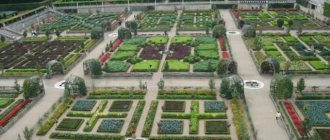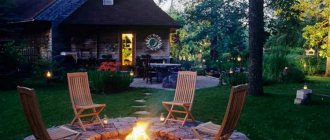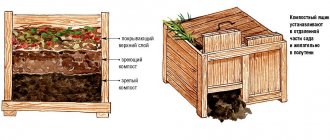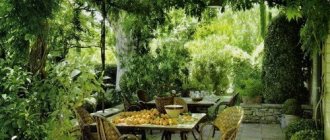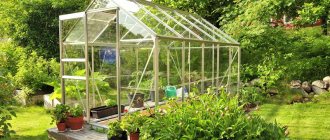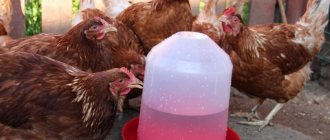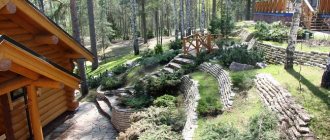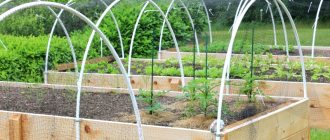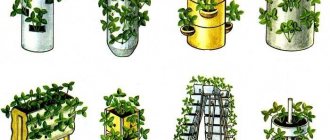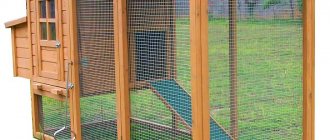Why are garden paths between the beds needed?
The main purpose of the garden path is to provide convenient access to the garden bed in any weather. They are rarely paved with expensive material. In addition, they do not lay it thoroughly. Firstly, no one sees the paths located on the far side of the yard. They are needed only for economic purposes. Secondly, the beds can be moved to another location when the site is redeveloped. The tracks will need to be moved along with them.
Capital paths are installed in the yard where the beds are installed on a permanent basis
In addition to providing access, covering paths between beds is necessary to solve the following problems:
- The undeveloped path is overgrown with weeds. It constantly needs to be mowed. If this is not done, ripened weed seeds will fall into the garden bed and germinate.
- The grass can be killed with herbicides, but then you will be left with bare soil. After every rain or watering, the gardener will have to wade through the mud.
- Moisture quickly evaporates through the bare soil near the garden bed. Plantings will have to be watered more often.
- The presence of paths improves the comfort of servicing growing crops. Labor productivity increases, and with it the harvest.
- The area decorated with paths looks beautiful. This is especially important if the beds are located in a visible place.
In addition to all the listed points, the owner himself benefits from the tracks. If you urgently need it, even during heavy rain you can go to the garden bed and pick cucumbers, tomatoes or other fruits. Otherwise, you will have to wait until the weather improves and the dirt dries out.
How to choose material
If you wish, you can close the paths between the beds with any material that you have lying around at home. Summer residents even use old carpets or pieces of linoleum that were going to be thrown away. If approached with all responsibility, the material must meet the following requirements:
- environmental cleanliness;
- resistance to decomposition in the ground;
- the ability to transmit oxygen, but prevent the penetration of UV rays into the soil;
- resistance to temperature changes and mechanical stress;
- affordability.
Preference is given to durable material that is not destroyed by contact with water.
Important! The covering material used for paths between the beds should not be slippery when wet. Otherwise, a person may slip and get injured.
Sawdust
Wood sawdust, shavings or small chips are a natural and affordable material for paths. They allow moisture and air to pass through well and are easy to use. Before filling, the soil between the rows is spilled with water. Then lay layers of covering material at least 3 cm thick and compact it thoroughly. You can also put geotextiles on the ground under sawdust or shavings - it is durable and water-permeable.
Sawdust from coniferous trees is first kept in a separate place for at least a year. Or they are treated with a urea solution before backfilling. They cannot be used fresh - they acidify the soil, which can lead to disease and death of cultivated seedlings.
How to cover paths between beds from weeds: popular solutions
In practice, materials that meet all requirements are rarely used. The paths are often paved with what can be obtained for free and is not a pity. However, some owners approach the problem carefully and buy slabs or special flooring.
Boards
From an environmental point of view, this is the safest material of natural origin. However, from the economic side it is not profitable. Buying boards is expensive. They will last a maximum of 5 years. You can extend their service life by treating the side in contact with the ground with bitumen. However, this won't last long.
Boards will quickly rot from contact with moisture and soil.
Advice! To extend the life of the boards, they are removed from the paths for the winter and stored in a shed.
Tree cuts
Log trims are similarly environmentally friendly natural material. Chocks have all the same disadvantages as boards. However, if the first ones can be taken to the barn for the winter, then the trick will not work with the saw cuts. Pulling out vertically buried logs in the fall and digging them in again in the spring is not so easy. However, due to the large thickness of hardwood chocks treated with bitumen, it is possible to achieve a service life of up to 10 years.
The path made from sawn wood is slippery after the rain
Rubber tracks
The rubber coating meets all requirements. The material can cover the ground from weeds between the beds and provide a non-slip passage. Rubber does not rot and is resistant to temperature changes and sunlight. The only drawback is the high costs. You can find a wide variety of rubber products in stores. Tiles will be cheaper. Usually they have a locking connection, which allows you to assemble the structure like a puzzle.
Rubber tiles will last from 10 to 20 years
Rubber crumb tiles have good decorative properties. It is produced in different colors, which allows you to create beautiful paths. However, due to the high cost, such a design is acceptable for beds located in the yard for public viewing.
Rubber crumb tiles have an anti-slip surface
If you don’t want to tinker with tiles, manufacturers offer rolled modular coverings. It is similarly made from crumb rubber. The material is rolled out along the path near the garden bed like carpet.
The roll coating does not allow air and water to pass through, due to which it does not create a “greenhouse effect” for the soil.
Plastic
PVC tiles have similar qualities to rubber flooring. The material does not decompose in the soil, eliminating the formation of the “greenhouse effect”. Thanks to the corrugated surface, the tiles are non-slippery. They are easy to move to another place when redeveloping the beds.
The disadvantage of PVC tiles is their high cost
Brick
Hard surfaces have always been at a premium. It is optimal to cover the paths between the beds with red brick. You can use pieces of concrete blocks. White sand-lime brick decomposes in the ground, but if there is no other option, you can use it. However, this material is beneficial if it remains after construction. Buying bricks for laying paths is expensive.
Whole bricks and halves are suitable for laying out paths
Agrofabric
For one season, you can cover weed paths between the beds with dense non-woven material. Agrofibre is used in black color. Minimum density 120 g/m2. It is useless to use thin fabric. It will quickly break through under your feet.
Agrofibre is used in black with a density of 120 g/m2
Ruberoid
The waterproofing material is resistant to moisture, but is susceptible to mechanical stress. It is optimal to arrange a solid base under the roofing felt. You can pour sand sifted from stones and compact it. However, no matter how hard you try, the roofing material will last for one season. If you walk along the path frequently, it will be pressed, broken, and worn out.
A solid base is installed under the roofing felt
Paths between beds made of crushed stone
It is reasonable to use crushed stone or gravel if the beds are not intended to be moved to another location. The stones are poured onto a geotextile backing, otherwise they will mix with the soil. The path will turn out beautiful, without weeds, allowing moisture and oxygen to pass through. However, walking on gravel is not very comfortable.
To prevent gravel from mixing with the ground, it is poured onto a geotextile backing
Paving slabs
A durable, reliable, environmentally friendly coating is a path made of paving slabs. The material is expensive. It is optimal to use it for beds located in the yard. The tiles are laid on sand without adding cement, which makes them easy to dismantle if necessary.
Paving slabs are laid on sand without adding cement
Lawn grass
In order not to spend money on purchasing materials, the path is simply sowed with lawn grass. For example, the seeds of bentgrass are introduced in mid-September. Fertilizers and sand are added to the soil. In spring, beautiful green grass sprouts. As it grows, it is trimmed with a trimmer.
Lawn grass is trimmed periodically to prevent the beds from becoming overgrown
Concrete
The technology of arranging paths with concrete requires a lot of labor. In addition, they cannot be moved if there is a desire to redesign the beds. A thin layer of concrete will crack due to seasonal soil movement. To create a reliable path, add a sand and gravel cushion and lay an armored mesh. The technology not only requires labor costs, but also financial investments.
The concrete coating is laid in compliance with the technology, otherwise it will crack during seasonal soil movement
How to cover the ground to prevent grass from growing
The issue of designing paths worries owners of gardens and vegetable gardens not only because of the aesthetic appearance of the site. Paths in the garden save you from mud on rainy days. Despite bad weather, you need to take care of the plants and monitor the ripening of the crop. Thanks to the covered path, dirt does not stick to shoes and is not spread throughout the area or enter the house.
If gardeners leave paths in the garden open, grass begins to grow between the rows. They fight it by diligently weeding the paths between the beds. Moisture evaporates through uncovered paths. To avoid drying out the soil of the beds and allowing weeds to grow, paths should not be left open with bare soil.
Construction and available materials are used to arrange the row spacing.
As a result, the tracks are either solid, for a long time of use, or easily dismantled when sheets of cardboard, roofing felt, or rough film are simply removed.
Different ideas for designing paths also arise because the pleasure of work and productivity depend on how comfortable the rows between the beds are.
do-it-yourself paths between the beds at the dacha. Photo
An excellent solution for designing paths between warm beds is to cover the space between the beds stone. Inexpensive material and the absence of difficulties in making the coating have made crushed stone an advantageous alternative to concrete, decorative tiles, and brick. Paths made from bulk materials have become one of the most economical options for paths in the garden and beds.
making paths in your dacha with your own hands. Photo
To cover the paths between the beds, sheets of roofing felt , flat slate , and slatted grids are . This coating is easy to install and can be removed and re-installed at any time. For mobile walkways, owners use materials that can withstand loads and have a rough surface with an anti-slip effect.
than filling paths between vegetable gardens. Photo
Pathway design ideas take into account the heavy load on the pavement, if it is foreseen. A wide path made of durable material is planned for carts with water, a trailer for storing harvested crops, and mobile transport. This does not have to be a concrete coating. natural stone tiles can withstand a lot of weight .
than to close the paths between the beds. Photo
It is convenient to cover the passages between farming zones with plant material . This can be wood chips, sawdust, tops, branches, stems.
The soft, all-natural surface is pleasant to walk on. For the winter, the walkway flooring can be removed with a rake and placed in the compost heap.
Such a path in the garden between the beds allows you to easily change the location of plots of land for growing plants.
Concrete paths are not only reliable and practical, but also aesthetically pleasing. You can lay out interesting patterns with pieces of ceramic tiles, like a mosaic, or select elements that are contrasting in color or similar in tone. The colored material pressed into the cement mortar creates an original-looking path and testifies to the good taste and diligence of the owner of the estate.
do-it-yourself paths between the beds at the dacha. Photo
When working with multi-colored brick, ideas for designing paths are not limited to its simple laying, because the material can be placed in a checkerboard pattern, fill the gaps with sand or stone chips, or leave gaps for small grass. Compositions made from paths and garden fences made of brickwork look beautiful.
You can fight weeds by clearing them from the rows and trampling the ground. To do this, the grass is dug up or cut with a hoe and removed from the garden. Level the surface with a rake and trample the ground. Weeds will not grow on trampled soil, and earthen paths between the beds will become an obstacle protecting the crop from moles and mice, which prefer loose soil for movement.
Stationary paths between the beds can be made of stones . Before laying stones, soil is selected from the row spacing, the surface is leveled, and a layer of sand is poured.
To prevent grass from getting through the cracks, you can put plastic film or geotextile fabric under the path.
The stones are selected by size and laid close to each other, choosing the flat and most attractive side for the top of the covering.
Vegetable gardens with beds fenced with large stones . They try to select the material of the same size so that it can be laid in horizontal stripes. The masonry is secured with concrete.
do-it-yourself paths between the beds at the dacha. Photo
No weed will get through the concrete
Walkways made of tiles laid on cement mortar are easy to keep clean - dirt is washed off the paths by rain; if you need to remove debris, the tiles can be swept up and cleaned with a stream of water.
The tile material is frost-resistant, resistant to wear and mechanical stress, and does not rot.
The path in the garden between the beds on the plot can be covered with colored stone chips .
To create such a covering, you need to remove 10 - 15 cm of the top layer of soil, line the created depression with non-woven geotextiles and secure the edges of the fabric with curb tape, fill the prepared area with crumbs, pebbles, and gravel.
Marble chips have a wide range of colors and granules of different sizes. Garden paths and between beds can be covered with material of the same color or the area can be made bright thanks to a combination of different shades saturated with color.
To ensure that the path in the garden between the beds is free of weeds and does not allow the soil to lose moisture, crushed stone .
The paths between the high fenced beds are leveled, the soil is strengthened with geotextile mesh and covered with construction rubble.
Crushed stone coating is not expensive; it is advantageous to use inexpensive building material to design wide, long paths.
Ideas for designing paths in suburban areas and on personal plots are primarily associated with the use of natural materials.
A wide path made from wood cuts in combination with large stones looks harmonious in natural surroundings.
To support the original design of the path using environmentally friendly materials and to prevent the stones from spreading, a low multi-level wooden fence was used.
From the saw cuts obtained by sawing up old uprooted trees, a completely wooden garden path is laid out. When laying, both wide elements obtained from the trunk and small ones prepared by sawing thick branches are used. Treatment with drying oil will help extend the service life of wooden elements.
do-it-yourself paths between the beds at the dacha.
How to choose a covering material against weeds: choosing a film
Have you ever seen in a forest or clearing, where Mother Nature herself is watching over the soil, even a piece of just bare earth? Of course not. Here is the root of all the problems of gardeners: by exposing the soil, uprooting even the slightest sprout, they allow it to dry out and overheat.
The wise ones mulch, trying to create the same cover, and those who are afraid of introducing pest seeds and do not have so much time to mow the “necessary” grass for mulch, acquire modern covering material against weeds, thereby making their lives much easier.
Already interested?
Why is covering material so good?
The first thing that is usually planted on mulching material for cover and because of which people decide to purchase it is strawberries. After all, it is much easier to grow it this way; you don’t have to replant it for 3 whole years and there are far fewer weeds. And positive reviews from grateful customers are especially encouraging - it’s time to put an end to “garden slavery.”
Interestingly, the soil under the film often remains looser than under the non-woven material. The fact is that in the latter, even the berry absorbs more moisture during the rainy season than from the ground. And strawberries on such a surface ripen much faster - much faster than ordinary ones. The berries are clean, not on the ground, dry and pleasing with a beautiful presentation. And the yield in the end is also higher.
Many people are surprised: how then to loosen the soil? The fact of the matter is that you only need to loosen “bare” soil, which is something you won’t find in nature. After all, this one gets weathered and becomes crusty, while nothing like that happens under the shelter - it perfectly retains moisture.
What is the best way to cover?
You can get special material at any gardening store or via the Internet - this is not a problem. Many are more interested in which type is better to take - thick or thin, film or non-woven, and what color.
Let's put it this way: black film, oddly enough, lasts much longer than non-woven material, and water is better retained in the soil underneath it - and this means a reduction in the amount of watering. Therefore, you can use both covering and the thinnest black.
It allows water to pass through and weeds do not grow.
But why is two-color film so popular? The thing is that the white, silver and yellow color on top does not allow the soil to overheat, and therefore these are more favorable conditions for earthworms, as well as for the roots. Advantages:
- Fruits and berries do not touch the ground, and in the end they turn out perfectly clean.
- Weeding is not needed, and the amount of watering is reduced significantly.
- The crop ripens faster.
- Farming is absolutely environmentally friendly.
And all thanks to the fact that the outer white layer reflects the light that falls on the plants, while the black inner layer suppresses the growth of pests. And at the same time, the material itself breathes well and even allows water to pass through, protecting the soil and plant roots from overheating and burns. Why water less? Because in this case, much less moisture evaporates from the soil.
How to carry out installation correctly?
According to the rules, in any material for covering plants you need to make a hole crosswise - and then plant it in it. But the experience of many summer residents shows that it is much more rational to cut a small round hole. After all, the corners often cover the plant, but it is easier to fill the hole with soil later.
Source: https://faneraosb1.com/chem-zakryt-zemlyu-chtoby-ne-rosla-trava/
How can you fill the paths between the beds?
Bulk materials are similarly used for arranging paths. They have more disadvantages compared to slabs. Most often this is due to the difficulty of clearing paths of debris.
The cheapest option is to fill the paths between the beds with sand. The minimum layer thickness is 50 cm. Water does not accumulate on the sand. After compaction it is dense. However, sand sticks to shoes, spreads throughout the area and rushes into the house.
Sand is poured 50 cm thick
Fine stone chips are considered a good bulk material for designing paths. It is poured onto a geotextile backing. As is the case with crushed stone, it is inconvenient to walk on the crumbs or roll a wheelbarrow or other garden tools on wheels.
Stone chips are poured onto a geotextile backing
Crushed stone
Well suited for areas with a flat surface, without slopes. You can use both an expensive option - granite, and a cheaper one - limestone. The main thing is to adhere to a certain installation technology. It is necessary to mark the boundaries of the path in advance, dig a trench 15 cm deep. Compact the soil at the bottom and cover it with geotextile. Then fill in a layer of crushed stone, spill it with water and compact it as well. Then add a second layer of material. Cover the top with sand if desired.
It is necessary to make borders on the sides of the paths. If they are not built, the crushed stone will crumble over time.
Material prices
The gardener is concerned not only with the quality, but also with the price of the material. Here it is worth learning one rule: the more reliable it is, the more expensive it is. The owner himself must decide what he wants to get: a cheap path for one season or an expensive, reliable coating that will last more than 10 years.
If we take concrete tiles as an example, the cost per piece is from 45 to 400 rubles. It all depends on the size, thickness, production technology. Plastic tiles will cost approximately 1300 rubles/m2. It’s cheaper to buy a roll of dense geotextile 100 m long for 2-3 thousand rubles. The same goes for roofing felt or film. However, a coating made from such materials will last a season, after which new costs will be required to purchase it.
Household waste
Many gardeners use items considered household waste, such as leftover linoleum or construction waste, to design paths between garden beds. These materials successfully prevent paths from becoming overgrown with weeds.
It is very convenient to use linoleum, as it is moisture resistant. In addition, this material is easy to cut into pieces of suitable size. Always lay linoleum with the rough side up so that your feet do not slip on it.
READ ALSO: Organizing the sale of crops: 7 rules to help avoid a fine
Creating a path from plastic corks will require a lot of time and also patience. The result will be an original coating that is comparable to a real work of art. You can line the passages with pieces of construction waste, for example, roofing felt or fiberboard. To prevent the germination of weeds, the soil must be covered with film before laying materials.
Sometimes old carpets and textile coverings are used to protect paths from weeds. They are convenient because cutting such materials into strips of the required width is not difficult, and laying these strips does not require any effort.
The classic option for creating passages is ordinary boards. They are used to make floorings, and are also simply laid on the ground. Such paths are practical to use, but pests often live under them.
Rules for constructing paths between beds
The layout of the paths depends on the location of the beds. After all, it is for their sake that the approach is arranged so that it is convenient to maintain the plants. Paths must ensure free movement along them. This point is still being thought through at the stage of laying the beds. It is optimal to leave a path 80 cm wide. You can not only walk along it, but also ride a wheelbarrow. When there is a shortage of space on the site, the owners narrow the paths to 50 cm. You won’t be able to drive along them with a wheelbarrow, but you can walk along them.
The width of the path should be enough for comfortable movement along it.
It is optimal to cover the paths between the beds with removable material so that it can be easily dismantled when redeveloping the site. It is irrational to pour solid concrete paths. It is not advisable to keep the beds in one place. Even with constant fertilization of the soil, it becomes depleted over time. The beds need to be moved to another place, which will not be possible with concrete paths.
Regardless of the materials used, paths are laid out according to the following rules:
- The row spaces are cleared of weeds. Use a shovel to clear away the turf layer with grass roots.
- The soil in the cleared area is leveled and compacted.
- The surface of the ground is covered with any material that prevents the germination of grass. Usually geotextiles or dense black agrofibre are used. A canvas backing will prevent grass from growing on the path
- One of the selected materials is laid on top of the covering sheet. It doesn’t matter whether it is loose or in the form of tiles. The canvas backing is abandoned only in one case, when the path is sown with lawn grass.
The benefits of gravel paths
Most often, paths are made of gravel or crushed stone. Every owner of a garden plot will be able to make beautiful paths in the garden with his own hands. To make the garden truly pleasing to the eye, you first need to make a drawing of the site. The drawing should definitely indicate the location of beds with vegetables, areas with flowers and other plantings. It is not worthwhile to arrange the paths chaotically and haphazardly.
After planning the passages through the garden, the question arises - what to fill with? A path covered with crushed stone and bordered along the edge with a simple brick or curb stone will look good.
Crushed stone can be combined with pebbles, gravel and other bulk materials, creating a unique landscape design.
Trail material options:
- pebbles,
- crushed stone,
- granite crushed stone,
- gravel,
- small pebble,
- large pebble.
The peculiarity of backfilling with the listed material is that the path cannot be made high, 7 cm is enough, since the stones are mobile, which makes it difficult to move along the surface.
DIY paths between garden beds made from waste
Waste will help you arrange the approach to the beds completely free of charge. In other words, it is trash that is usually thrown away. To search for material, you need to look around in the yard.
From sawdust
If there is a sawmill at home or nearby, sprinkle the paths between the beds with sawdust, wood chips, and shavings. A geotextile backing is placed under the bulk material. In 1-2 seasons, the wood will turn into natural fertilizer. It is put into a compost heap, and new sawdust is poured onto the paths.
Rotted sawdust is used for fertilizer
From newspapers and magazines
For one season, you can cover weed paths between the beds with old newspapers and magazines. However, thin paper quickly becomes soggy from moisture. It is optimal to throw thick cardboard from the packaging container on top.
Torn cardboard boxes are laid out near the garden bed on top of the mown grass.
From compost
Compost paths solve several problems at once: they provide fertilizer, provide good access to the beds, and solve the problem of disposing of organic waste. According to the technology, the row spacing is first deepened by 30 cm. Grass and tops of garden crops are laid in the ditches. Cover everything with manure and water it with a biological product containing live bacteria. The organics are covered with agrofibre and a hard surface on which you can walk. When the organic matter rots away after a year, the beds are moved to this place, and new row spacing is prepared according to a similar principle.
Compost paths can be laid in autumn and spring, but the first option is better, since after harvesting a lot of organic raw materials remain
From the lids
Those who have a lot of patience and an interest in creativity can cover the paths from weeds between the beds with mats made from plastic bottle caps. The coating will be good and even beautiful in all respects. However, you will need to collect a huge number of plugs and connect them together with wire. Using multi-colored elements is convenient when creating patterns.
A cork mat is laid on a geotextile backing, and sometimes even embedded in concrete
Paving slabs
The covering has a number of advantages: it prevents the germination of weeds, can be laid on sloping terrain, and provides easy access to the beds even after heavy rain.
When laying paving slabs, it is important to strictly follow the process technology:
- Determine the size and shape of the path.
- Remove the soil.
- Create a load-bearing layer at the base.
- Install edge stone around the perimeter.
- Lay the underlying layer and tiles.
- Fill the seams.
The tiles are laid starting from the significant element of the site - the gate or doors of the house. Every 3-5 rows, use a cord to check how evenly the tiles lie.
If you study the technology and think through everything in advance, the track will last a very long time.
Advice from gardeners
To arrange the approach to the beds, gardeners advise not to use expensive materials. In most cases, paths are intended only for maintenance of plantings and do not serve a decorative purpose. Rarely does anyone want to plant garden crops in their yard for everyone to see.
Scrap materials can always be found at a landfill or construction site. The bigger problem will be getting them to the site.
If you look at the benefits, then compost rows are the best option. The work is difficult, but the gardener is guaranteed to achieve an increase in yield.
